
by Matt Lollar | Oct 8, 2019
Last week at the Panhandle Fruit and Vegetable Conference, Dr. Ali Sarkhosh presented on growing pomegranate in Florida. The pomegranate (Punica granatum) is native to central Asia. The fruit made its way to North America in the 16th century. Given their origin, it makes sense that fruit quality is best in regions with cool winters and hot, dry summers (Mediterranean climate). In the United States, the majority of pomegranates are grown in California. However, the University of Florida, with the help of Dr. Sarkhosh, is conducting research trials to find out which varieties do best in our state.
In the wild, pomegranate plants are dense, bushy shrubs growing between 6-12 feet tall with thorny branches. In the garden, they can be trained as small single trunk trees from 12-20 feet tall or as slightly shorter multi-trunk (3 to 5 trunks) trees. Pomegranate plants have beautiful flowers and can be utilized as ornamentals that also bear fruit. In fact, there are a number of varieties on the market for their aesthetics alone. Pomegranate leaves are glossy, dark green, and small. Blooms range from orange to red (about 2 inches in diameter) with crinkled petals and lots of stamens. The fruit can be yellow, deep red, or any color in between depending on variety. The fruit are round with a diameter from 2 to 5 inches.
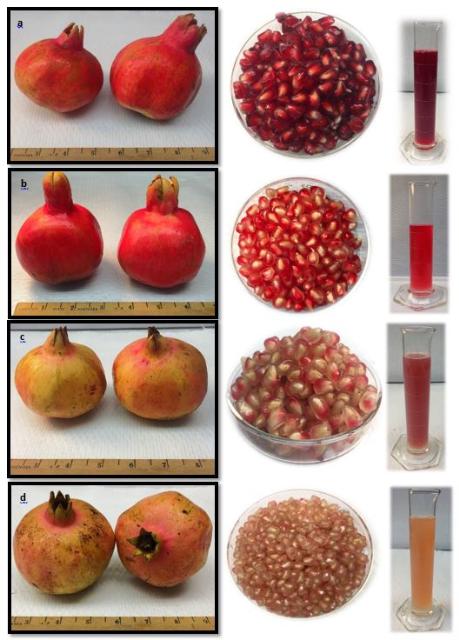
Fruit, aril, and juice characteristics of four pomegranate cultivars grown in Florida; fruit harvested in August 2018. a) ‘Vkusnyi’, b) ‘Crab’, c) ‘Mack Glass’, d) ‘Ever Sweet’. Photo Credit: Ali Sarkhosh, University of Florida/IFAS
A common commercial variety, ‘Wonderful’, is widely grown in California but does not perform well in Florida’s hot and humid climate. Cultivars that have performed well in Florida include: ‘Vkusnyi’; ‘Crab’; ‘Mack Glass’; and ‘Ever Sweet’. Pomegranates are adapted to many soil types from sands to clays, however yields are lower on sandy soils and fruit color is poor on clay soils. They produce best on well-drained soils with a pH range from 5.5 to 7.0. The plants should be irrigated every 7 to 10 days if a significant rain event doesn’t occur. Flavor and fruit quality are increased when irrigation is gradually reduced during fruit maturation. Pomegranates are tolerant of some flooding, but sudden changes to irrigation amounts or timing may cause fruit to split.
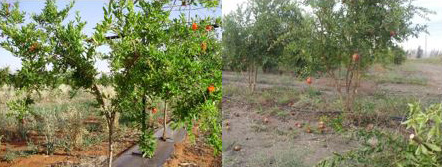
Two pomegranate training systems: single trunk on the left and multi-trunk on the right. Photo Credit: Ali Sarkhosh, University of Florida/IFAS
Pomegranates establish best when planted in late winter or early spring (February – March). If you plan to grow them as a hedge (shrub form), space plants 6 to 9 feet apart to allow for suckers to fill the void between plants. If you plan to plant a single tree or a few trees then space the plants at least 15 feet apart. If a tree form is desired, then suckers will need to be removed frequently. Some fruit will need to be thinned each year to reduce the chances of branches breaking from heavy fruit weight.
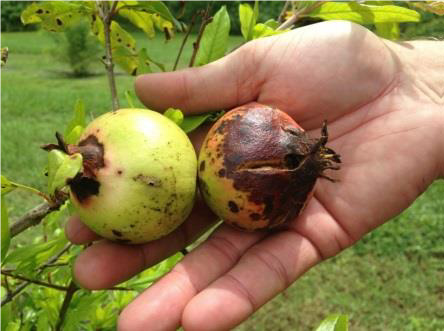
Anthracnose caused by Colletotrichum sp. to pomegranate fruit. Photo Credit: Gary Vallad, University of Florida/IFAS
Anthracnose is the most common disease of pomegranates. Symptoms include small, circular, reddish-brown spots (0.25 inch diameter) on leaves, stems, flowers, and fruit. Copper fungicide applications can greatly reduce disease damage. Common insects include scales and mites. Sulfur dust can be used for mite control and horticultural oil can be used to control scales.
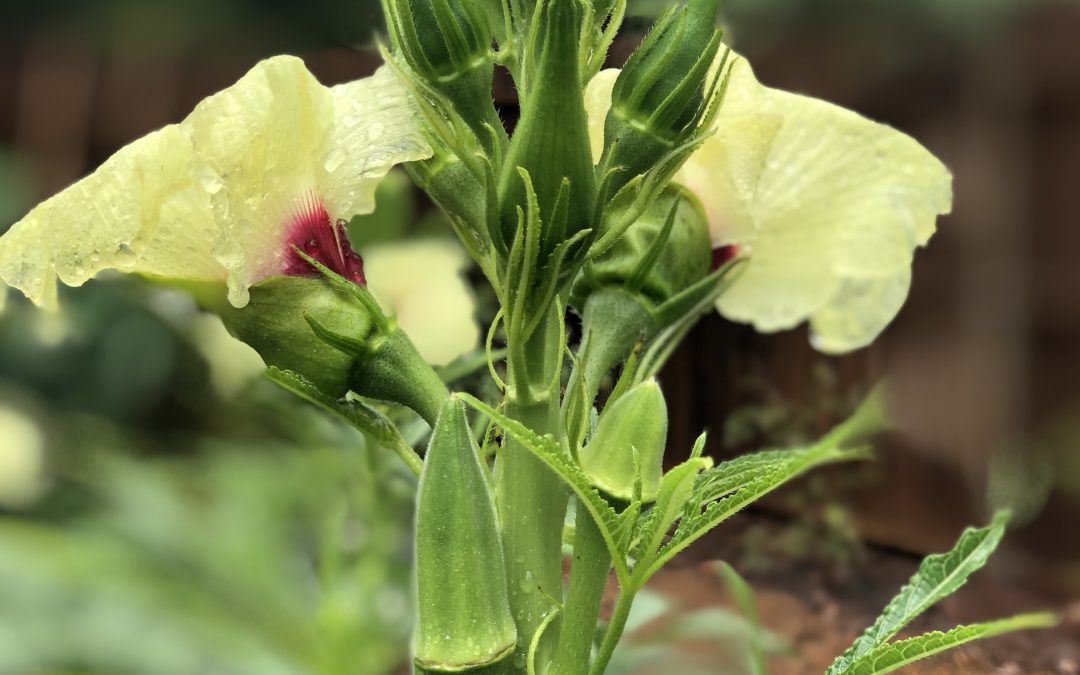
by Daniel J. Leonard | Aug 20, 2019
Though Okra (Abelmoschus esculentus) fruit isn’t much more than a thick green hull, slime and seeds and the plant itself is impossibly irritating to the skin, few plants are as integral to Southern heritage. In my mind, okra is among the best vegetables Panhandle gardeners can grow. Not only is it a gorgeous plant – Okra belongs to the Mallow family which also includes beauties like Hibiscus and Cotton – but it’s exceedingly versatile in the kitchen, excellent fried, grilled, roasted, boiled (though you have to acquire a taste for slimy textures to enjoy this method) and most famously, as a thickening agent in Cajun gumbo. Because of this exalted status in Southern culture, whether you enjoy eating okra or not, it’s almost mandatory here to include the plant in one’s garden. Most gardeners stick with the old standard varieties such as ‘Clemson Spineless’ or ‘Cowhorn’ and there is nothing wrong with them, however, these plants are almost too prolific for most gardens (growing upwards of 6-7’), especially for those of us growing in the close confines of raised beds. In the search for a less rambunctious but still ultra-productive cultivar, this summer I trialed ‘Jambalaya’, an F1 hybrid developed by Sakata Seed in 2012, with impressive results!
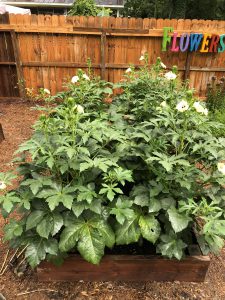
‘Jambalaya’ Okra in the author’s garden.
From my experience growing the cultivar this summer, ‘Jambalaya’ merits consideration in the garden, and is a must for raised bed gardeners, for two primary reasons. First, it was bred to be compact and is considered a dwarf cultivar. This is an awesome attribute, as I typically end the growing season picking okra from a small ladder! Most seed purveyors tout the plant as reaching a maximum height of 3-4’ and while this estimate might be a little conservative, I can attest that ‘Jambalaya’ is greatly reduced in height compared to the standard cultivars. The second advantage of growing this variety is that it begins producing very early relative to its peers and bears heavily. ‘Jambalaya’ fruit begin to ripen in about 50 days, about ten days to two weeks earlier than ‘Clemson Spineless’, a definite advantage if rotating behind a late maturing spring crop like potatoes as I typically do. Though ‘Jambalaya’ is a dwarf plant, in no way are yields reduced. My specimens have produced continuously since late-July and will continue to do so as long as adequate fertility and consistent harvesting are provided.
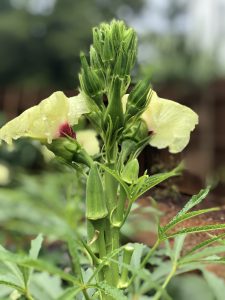
‘Jambalaya’ flower & fruit production.
Like any other okra cultivar, ‘Jambalaya’ has a couple of basic requirements that must be met for plants to thrive. In general, all okra cultivars love Southern summers and patience sowing seed is recommended, allow the soil to warm to at least 70 degrees before planting. Okra also prefers full sun, at least 6 hours per day, any less and yields will be reduced and plants will stretch towards the light. Belonging to the Mallow family, okra requires consistent moisture, particularly when in the flowering and fruiting phase. Finally, it is critical to keep up with your okra harvest as the plants produce! Okra pods grow quickly and should be harvested when they are no more than 3-4” long and still tender, larger pods are tough to the point of being inedible!
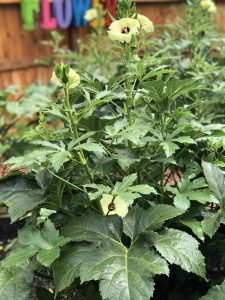
‘Jambalaya’ in the author’s garden.
Whether you’re new to the okra growing game or you’re a seasoned gumbo gardener, I highly encourage you to give ‘Jambalaya’ Okra a look next summer. While ‘Jambalaya’ is available through many seed sources, Johnny’s Selected Seeds sells a conveniently small package perfect for backyard gardeners, though they’ll be happy to provide larger quantities as well. In ‘Jambalaya’ you’ll find a nice compact plant that won’t outgrow your space, provide you a summer long harvest of tender green pods, and will rival the ornamentals in your landscape for the title of prettiest plant on your property! Happy gardening and as always, if you have questions about vegetable gardening or any other horticultural or agronomic topic, please contact your local UF/IFAS County Extension office!
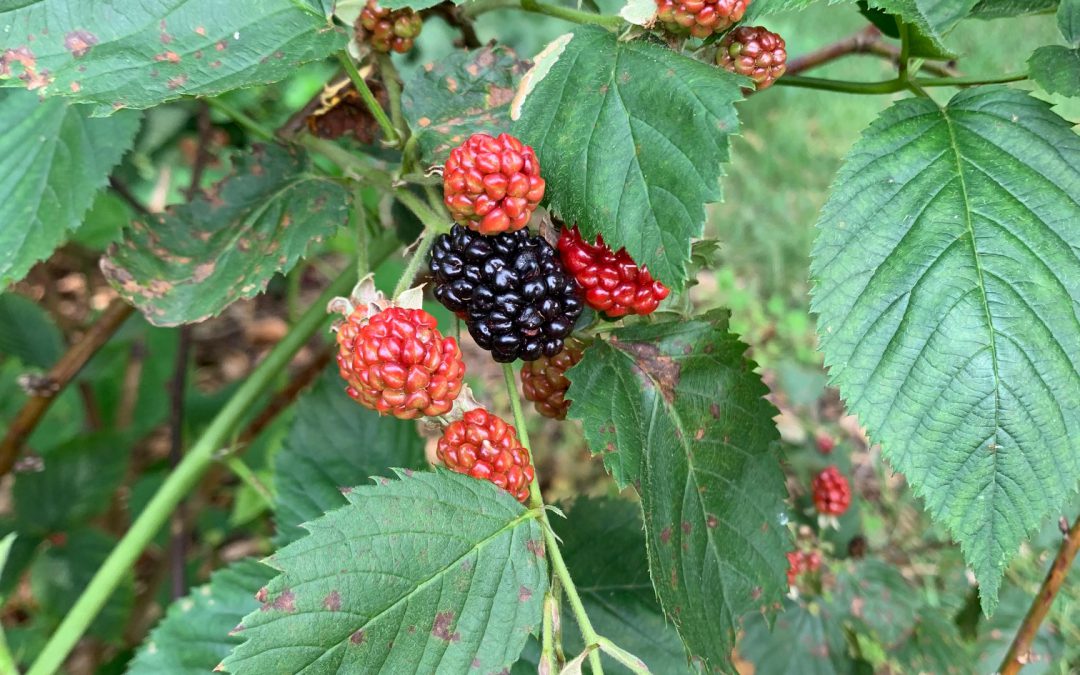
by Mary Salinas | Jul 11, 2019
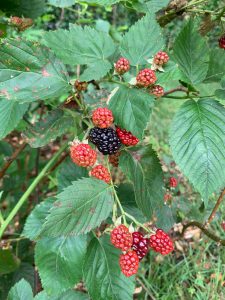
Ripening thornless blackberries. Photo credit: Mary Salinas, UF/IFAS Extension.
To everyone’s delight, the blackberries are ripening in the Santa Rosa County Extension demonstration garden. The blackberry patch is a reliable perennial that continues to provide fresh berries year after year. Before you decide against them because you don’t want a thorny and painful hazard in your landscape, remember that there are thornless blackberry cultivars with fruit just as tasty as the old-fashioned thorny blackberry varieties. However, it is important to take care and make sure that the variety or cultivar you choose is adapted to our Florida climate and chill hours.
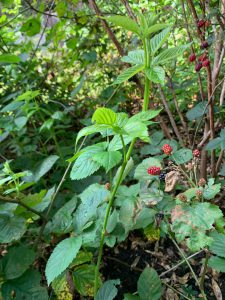
Blackberries bloom and produce fruit on last year’s canes. This year’s growth (the bright green shoot in the front center) will produce next year. Photo credit: Mary Salinas, UF/IFAS Extension.
You can choose a blackberry variety from your local nursery or propagate some plants from a favorite blackberry grown by a friend or neighbor (with permission, of course). Methods of propagation include stem cuttings, root cuttings, tip layering and removing the suckers that arise from the roots.
Plant when the weather is cooler in winter and choose a sunny spot with good soil. Frequent irrigation is crucial during the establishment period and when the fruit is produced. Weed control with organic or plastic mulches is also important to the success of your blackberry patch.
For more information on blackberry cultivars, propagation and growing success please see the University of Florida publication The Blackberry.
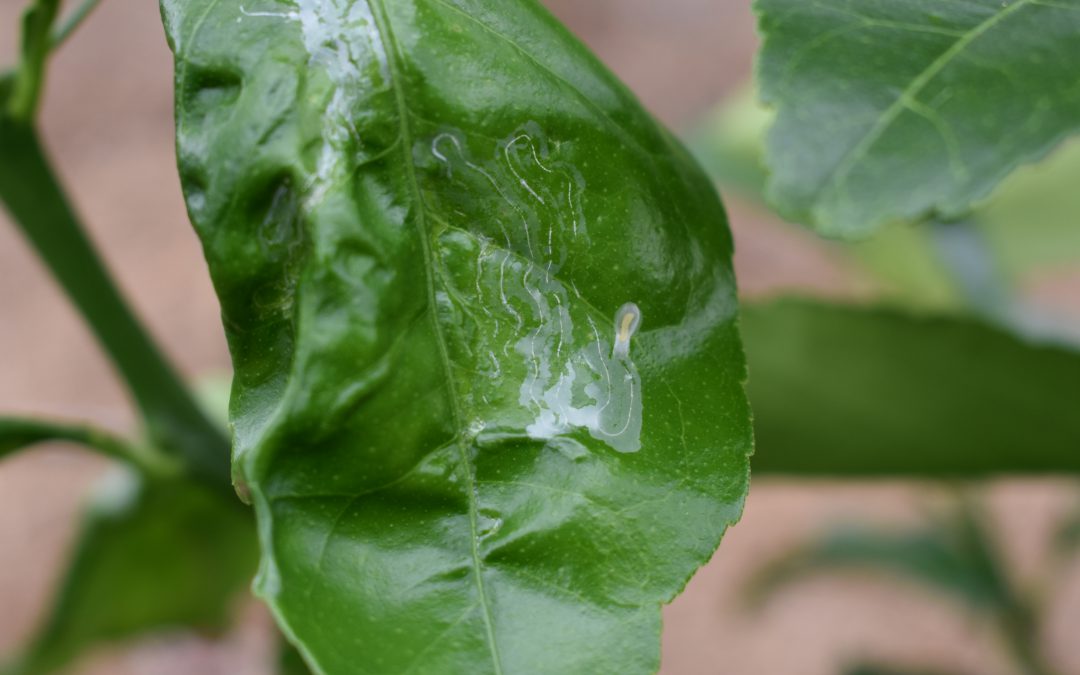
by Danielle S. Williams | May 20, 2019
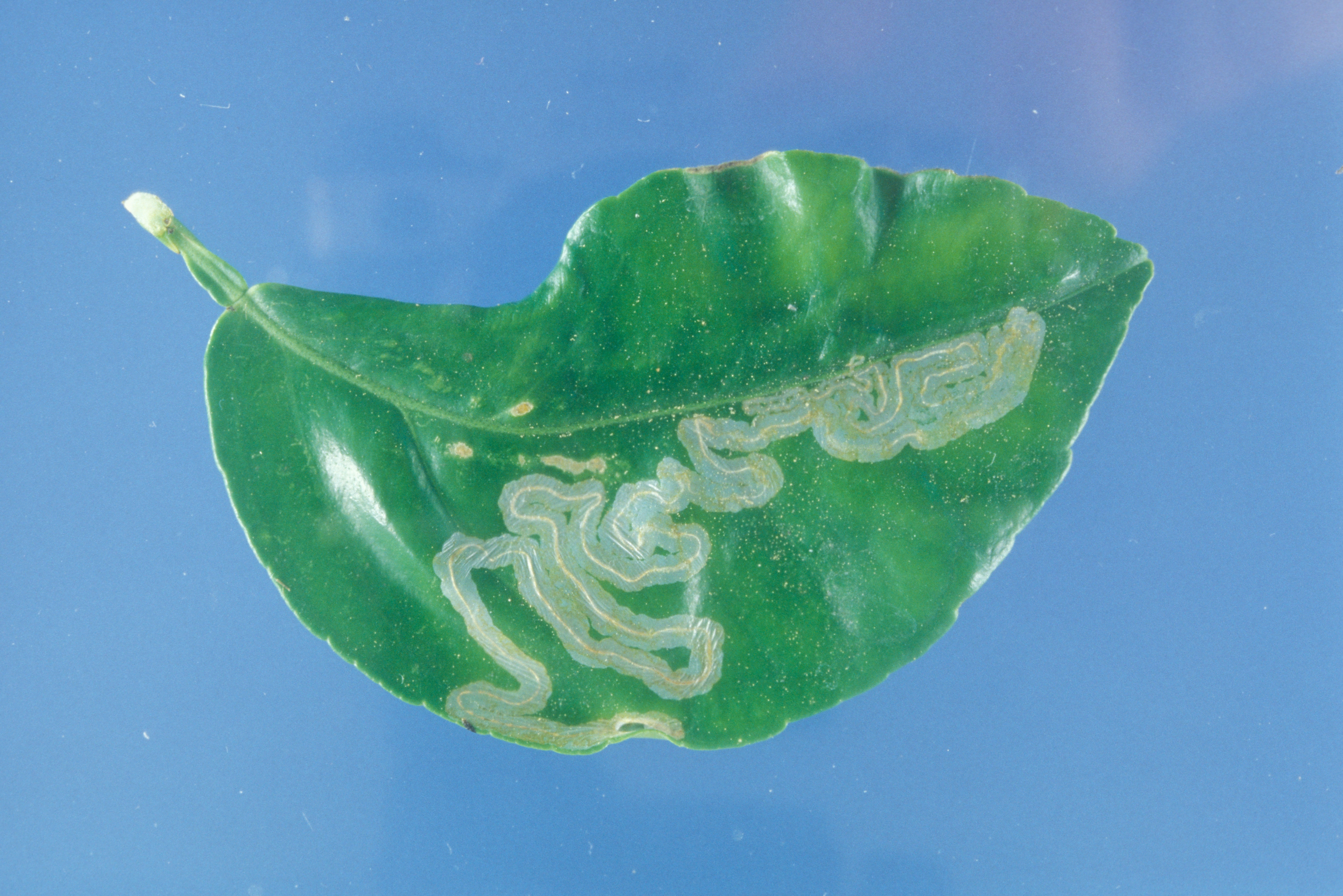
Citrus leafminer injury. Photo: James Castner
Spring is in full swing and citrus trees have begun actively flushing. With the new flush comes an array of insect pests. One of the most common being the citrus leafminer. The citrus leafminer is a small white moth, about 2.4 mm in length. It is more easily detected during its larval stage by the serpentine larval mines it produces on the underside of citrus leaves.
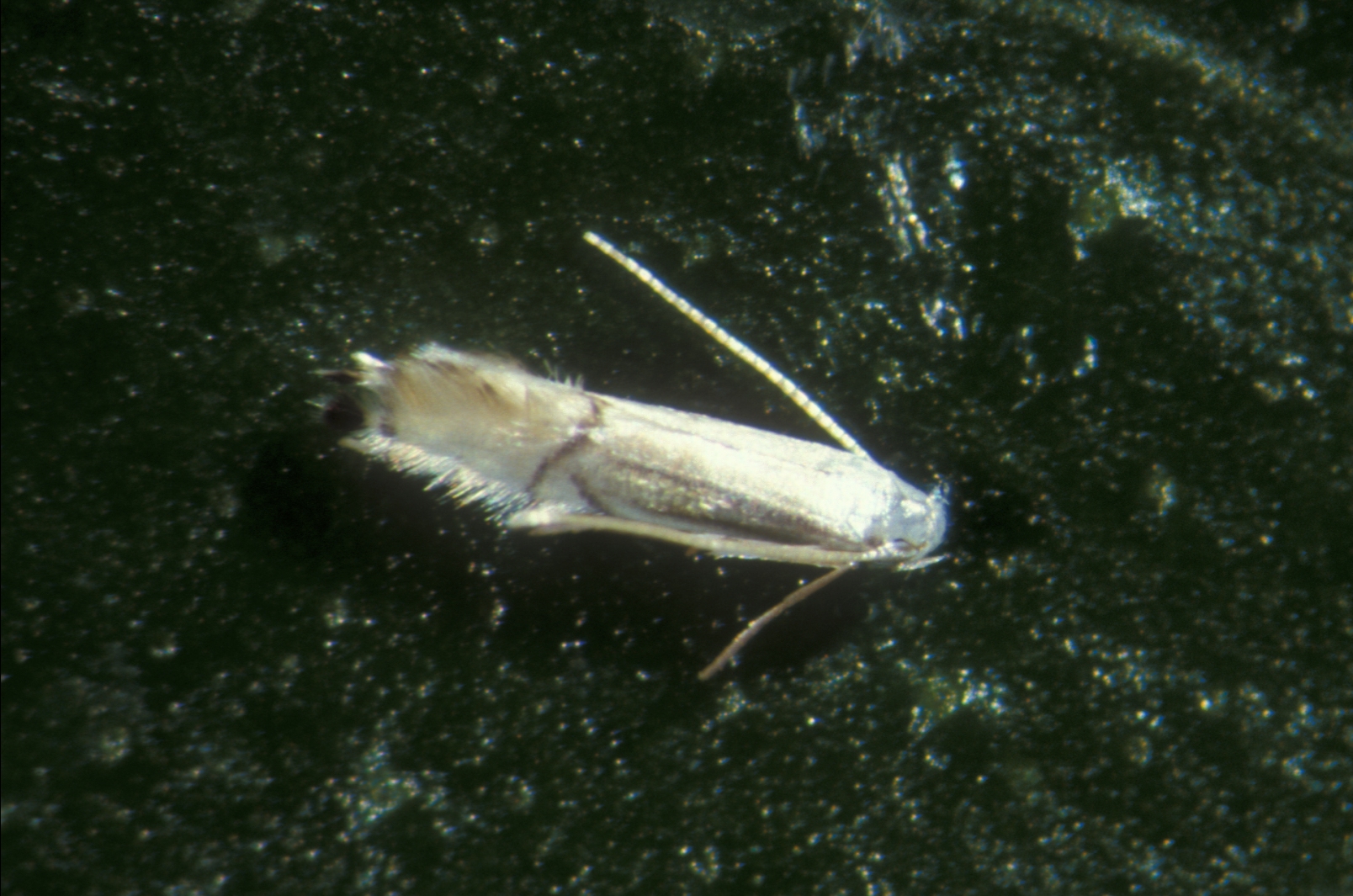
Citrus leafminer adult. Photo: James Castner
The larvae of the citrus leafminer feed on the new growth or flush of citrus causing serpentine mines to form under the leaf cuticle. This can result in leaf curling and distortion. Citrus leafminer injury to foliage can stunt the growth of young trees and in areas where the citrus canker pathogen is present, provide an opening for infection.
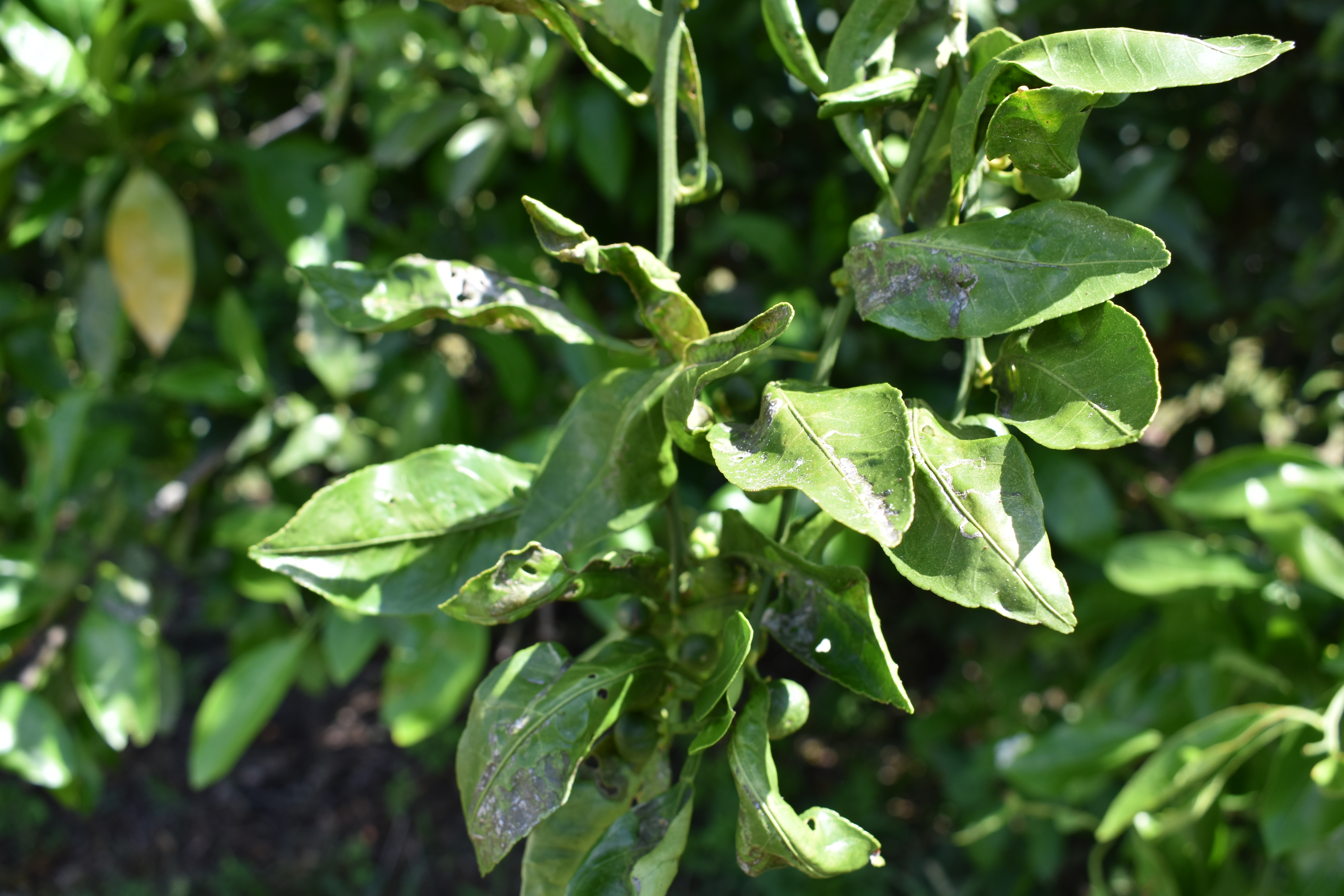
Distortion and leaf curling caused by citrus leafminer. Photo: Danielle Sprague
The term ‘flush’ is commonly used to describe the new foliar growth between bud break and shoot expansion. Citrus trees usually have several flushes per year, depending upon cultivar, climate and crop load. Generally, most citrus cultivars in our area have around three flushes. The main flush is the spring flush in late winter/early spring. Following that, two additional flushes occur around the end of June and late September.
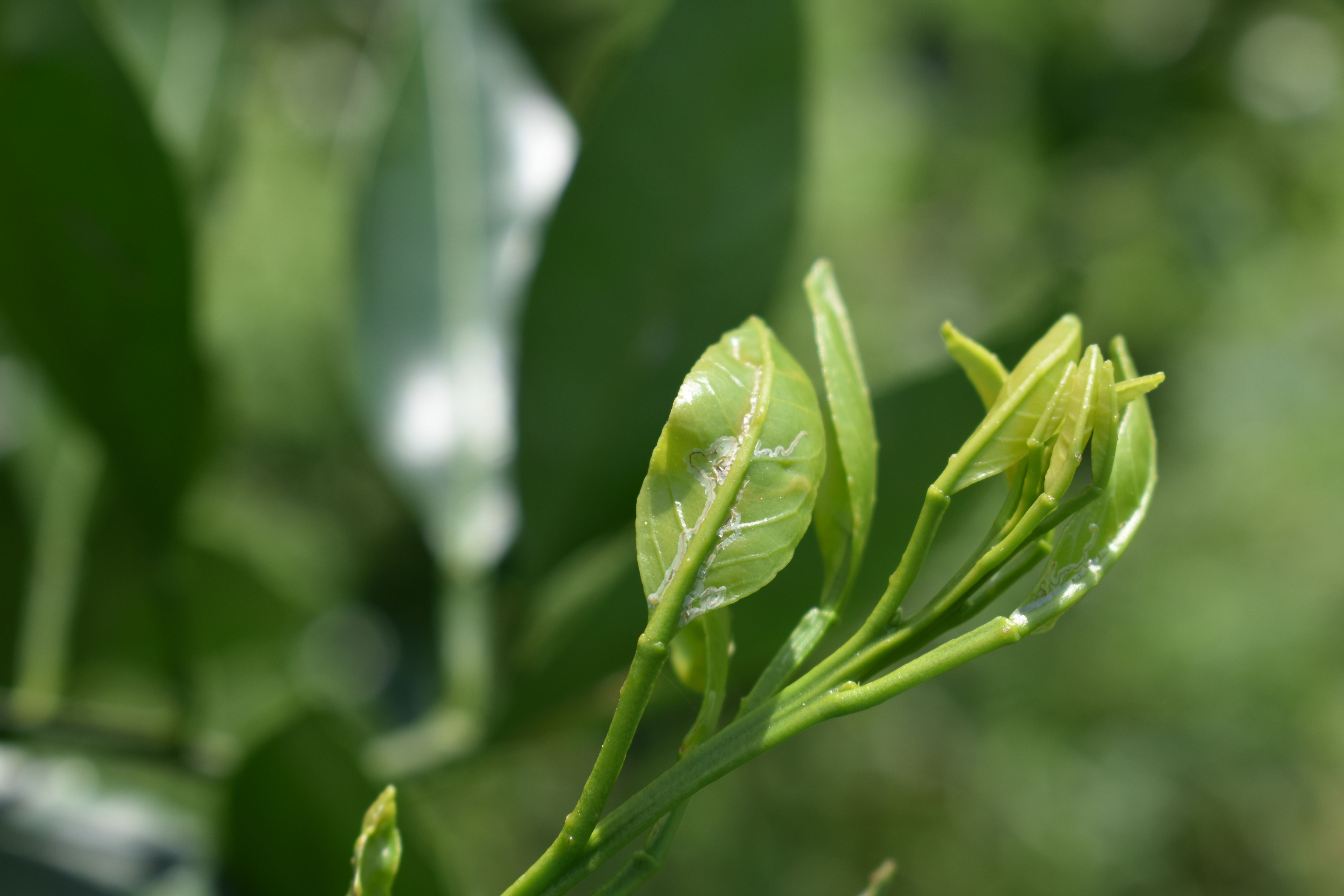
Citrus leafminer on young flush. Photo: Danielle Sprague
Adult leafminers require the new citrus flush for development. Eggs are laid within the flush. After two to ten days, the larvae emerge and feed causing the mines to occur. Larvae are protected within the leaf and therefore difficult to control. Pupation occurs within the leaf mine and takes anywhere from six to 22 days, depending upon temperature. Adults emerge around dawn and are most active in the morning and evening. In Florida, one generation of citrus leafminer is produced about every three weeks but populations increase when citrus trees are flushing.
In Florida, several natural enemies assist with reducing citrus leafminer populations. Studies have shown that predation from natural enemies can reduce leafminer populations by 90%. Primary predators of citrus leafminers include ants, lacewings and spiders. A parasitic wasp, Ageniaspis citricola was introduced into Florida and has become established. The parasitic wasp attacks the immature stages of citrus leafminer. Ageniaspis citricola can be requested and obtained for free from the Florida Department of Agriculture and Consumer Services (FDACS). Because it is a specialized parasitoid of the citrus leafminer larval stage, it should be released only when mines start to become visible on flush.
Citrus leafminer can be difficult to control with insecticides due to the fact that they are within the leaf and protected. Applications of insecticides require proper timing and may require repeat applications. For a full list of insecticides, contact your local Extension Office.
For more information on citrus leafminer, use the links to the following publications:
Citrus Leafminer, Phyllocnistis citrella Stainton (Insecta: Lepidoptera: Phyllocnistinae)
Citrus Leafminer Control – UGA
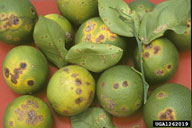
by Mary Salinas | May 11, 2017

Citrus canker symptoms on twigs, leaves and fruit. Photo by Timothy Schubert, FDACS
In November 2013, citrus canker was found for the first time in the Florida panhandle in Gulf Breeze in southern Santa Rosa County. The Florida Department of Agriculture and Consumer Services (FDACS) tested and confirmed the disease on grapefruit trees in a residential landscape. Since that time, citrus canker has been confirmed on citrus trees at 27 more locations in Gulf Breeze. To my knowledge it has not been found in any other location in the panhandle. Not yet.
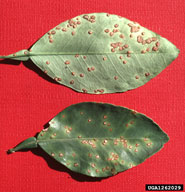
Citrus canker lesions on leaves are raised, rough and visible on both sides of the leaf. Photo by Timothy Shubert, FDACS.
Citrus canker is a serious bacterial disease that only infects citrus trees. It will not infect any other plant species nor is it a threat to human health. This highly contagious disease has no cure as yet. Severely affected trees experience substantial leaf and premature fruit drop and serve as a source for infecting other citrus in the area. The disease spreads through wind, rain and transportation of infected plant material from other locations.
We do not know how the disease came to infect trees in our region. The disease could have been spread through infected fruit or trees brought here from areas where the disease is established, such as central or south Florida.
What should you do if you suspect your citrus is infected with this disease?
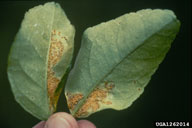
Citrus canker lesions can appear in the mines left by the citrus leafminer pest. Photo by Timothy Schubert, FDACS
- Look at Homeowner Fact Sheet: Citrus Canker for more information.
- Leave the tree in place in your yard and call the Division of Plant Industry at FDACS at 1-888-397-1517 for a free inspection and testing of your citrus trees.
- Consult your local Horticulture Extension Agent for more information and control/removal strategies.
- Proper removal of infected trees is recommended to prevent the spread of citrus canker but is not mandatory.
For more information please see:
Save Our Citrus Website
UF IFAS Gardening Solutions: Citrus
Citrus Culture in the Home Landscape
UF IFAS Extension Online Guide to Citrus Diseases



















